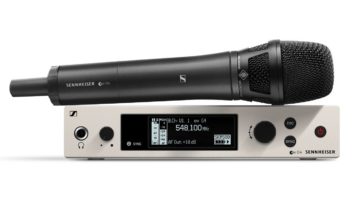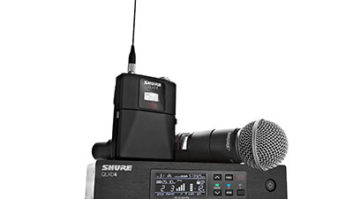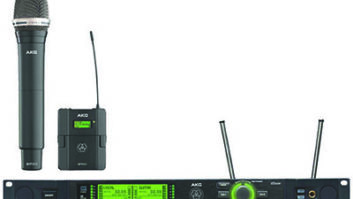Long before Shure entered the wireless market, concert engineers specified cordless mics with SM58 or SM87 capsules. Since introducing its own UHF system — and discontinuing the supply of capsules for others — Shure has grown to dominate the market, at least for live and broadcast music applications. When Shure introduced the new ULX wireless system, what caught my attention was the claim that it could sound as good as a wired mic. As it turns out, the claim is well-founded.
There are two versions of the ULX system, Standard and Professional, and the same wide range of handheld and beltpack transmitters work for both. The differences are all in the receivers. The Standard receiver’s chassis is plastic, while the Pro’s is the same metal chassis found on the PSM-400 transmitter and includes a rackmount kit. Both units contain backlit LCDs that show group and channel selection plus a three-segment battery “fuel gauge,” but the Pro can also display the six-digit frequency.
The Standard receiver comes with detachable quarter-wave whip antennae, but the Pro’s longer half-wave antennae, which provide similar RF performance, can also be remoted with a co-ax BNC cable. Both receivers have five-segment LED audio meters, but the Pro also has five-segment RF metering, whereas the Standard has only a single RF idiot light.
The coolest feature of the ULX is its ability to scan for clear channels. The Scan function on the Pro version goes further to scan all 10 groups to find the group whose spacing permits the greatest number of channels to operate. This is helpful when going up against interference from TV broadcasts. The Pro version’s five-segment RF metering is handy when marginal RF interference can be worked around with antenna strategies.
The ULX operates on more than 1,400 frequencies across a range of 36 MHz, and up to 20 units can be operated in one of 10 preset groups. There are two North American RF bands, J1 (554 to 590 MHz, or TV channels 28 to 34) and M1 (662 to 698 MHz, or TV 46 to 52). When combined, these two RF bands can provide up to 40 compatible channels. Two European bands mirror the U.S. bands, plus there’s another European RF band, a UK band and a Japanese band.
For comparison, Shure’s top-of-the-line system, the UHF, is available with four bands in the U.S.: J4 (554 to 584 MHz), M4 (662 to 692 MHz), UB (692 to 716 MHz) and UA (782 to 806 MHz). Up to 24 units can be operated compatibly in a single band, for a total of 78 possible simultaneous systems. The UHF and ULX systems’ J and M bands overlap but are not cross-compatible. The ULX operates over a slightly wider range in each band, the equivalent of covering an additional TV channel, offering better frequency coordination possibilities in metropolitan areas with the most RF crowding.
The ULX receivers use an in-line AC transformer rather than the IEC connector found on the UHF. The optional UA-844 is an RF and power combiner that distributes two antennae to four receivers, while eliminating all but one of the four power supplies. The 844 includes all cabling and cleans up the rack — a must for multiple unit systems. Other options include the UA-830 RF amp that can be used to add either 3 or 10 dB of gain for antenna cable runs when remoting the half-wave antennae. A familiar paddle-shaped directional antenna, the UA-870, offers 6 dB of gain and better reception in the area it’s pointed toward.
Holding the Mode key for 10 seconds as the ULX powers up allows the user to enter lower- and upper-frequency limits. This will stop the unit from scanning and accepting frequencies above or below the limits, a useful feature when known intermittent sources of interference might otherwise be accepted by the scanning feature. On the Pro version, the squelch can also be adjusted to help fight borderline interference.
The ULX handheld’s housing is made of plastic, and a plastic sleeve can be slipped on to cover its controls and display. It uses a 9-volt battery instead of two AAs, which makes battery changes faster. Capsules can be swapped out and are interchangeable with those from the UHF and other Shure systems. The ULX transmitters can be locked.
In the old days, wireless users could just turn on their system and hope for the best. There were enough problems that simply carrying a spare, or moving to a different frequency, was a workable solution. Now, airwaves are sufficiently congested that avoiding problem frequencies ahead of time is essential. The ability of the ULX’s scanning feature to reduce the headaches of RF interference alone might convince most intermediate users to go with this system for a variety of applications.
Perhaps the most striking feature of the ULX is its sound quality: There’s hardly any difference between the ULX and a wired mic. The older UHF system is a bit more robust, but the ULX is more user-friendly and sounds much better, plus it has the Scanning feature. And let’s talk prices: The Pro ULX with a 58 lists for $1,312, while the Standard ULX is $1,050, about half the price of the UHF.
While the ULX can’t compete with Shure’s top-of-the-line UHF Series software control and ability to operate more channels, the sound quality and scanning features are sure to make it a hit for second-tier wireless customers. Musicians who need only one system should consider the Standard, while installations and regional companies running multiple channels will appreciate the extras on the Pro. I won’t be at all surprised to see ULX systems appearing on tours and at festivals. It’s the best Shure wireless I’ve ever heard.
Shure Incorporated, 222 Hartrey Ave., Evanston, IL 60202-3696; 847/866-2200; [email protected].




